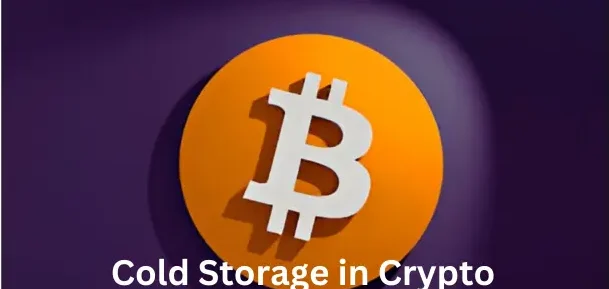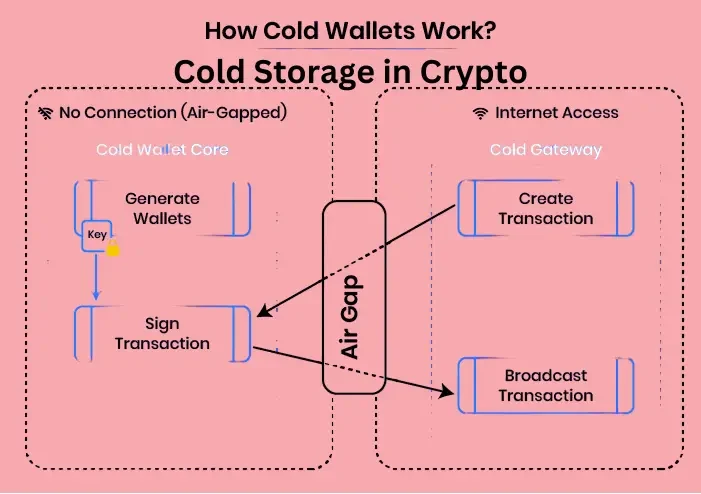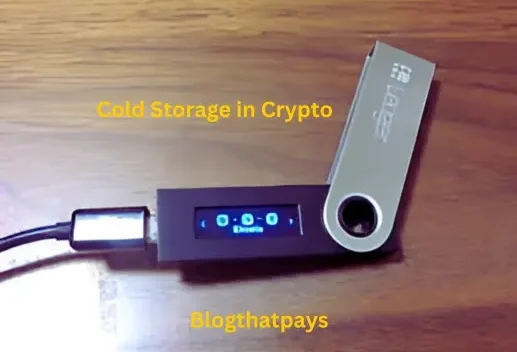What is Cold Storage in Crypto? A Beginner’s Guide to Secure Asset Preservation

In the realm of cryptocurrency, the concept of cold storage in crypto refers to the practice of keeping a reserve of cryptocurrency offline. This method is a security measure against unauthorized access, cyber hacks, and other vulnerabilities that a connection to the internet could pose. By securing cryptocurrency private keys—the cryptographic equivalent of a password—offline, cold storage reduces the risk of theft, as these keys are necessary for conducting transactions.
Cold storage options include hardware wallets, paper wallets, and other forms of secure physical media. Hardware wallets are physical devices that can store a user’s private keys securely and are designed to be immune to computer viruses that could infect a software wallet. A paper wallet is a physical document that includes a public address for receiving cryptocurrencies and a private key that allows you to spend or transfer the cryptocurrency stored at that address. These methods stand in contrast to hot wallets, which are connected to the internet and more susceptible to online theft.
Opting for cold storage in crypto comes with a trade-off between security and convenience. While it provides a higher level of security due to its offline nature, accessing funds stored in cold storage can be less convenient compared to using hot wallets. Users must carefully weigh their need for security against the convenience of quickly accessing their cryptocurrency when choosing a storage method.
Understanding Cold Storage
Cold storage is a security measure for holding cryptocurrency that keeps the private keys completely offline, thus shielding them from online vulnerabilities such as hacks and unauthorized access.
Crypto Wallets And Private Keys
A crypto wallet functions by generating private keys, which are essential for authorizing transactions within the blockchain. These keys are analogous to digital signatures, offering proof of the owner’s identity and granting them access to their assets. Cold storage denotes the practice of keeping these private keys on platforms that have no connection to the internet, such as hardware wallets or paper documents. This physical separation drastically reduces the risk of online theft.
- Hot Wallet: Connected to the internet; convenient but less secure.
- Cold Wallet: Not connected to the internet; more secure but less convenient for frequent transactions.
The Role of Recovery Phrases
In the context of cold storage in crypto, a recovery phrase serves as an additional layer of security. Usually a sequence of 12 to 24 words, this phrase is a human-readable form of the wallet’s master seed, vital for the regeneration of private keys in the event of device failure or loss. Users must store their recovery phrases separately in a secure location, as anyone with access to this phrase can potentially restore the wallet and access the contained funds.
- Essential steps for handling a recovery phrase:
- Write it down during wallet setup.
- Keep it in a secure and private location.
- Never share it online or with anyone who might pose a risk to fund security.
Storing Crypto using Hardware Wallets
Hardware wallets offer robust security by keeping cryptocurrency private keys offline, safeguarding them from online hacking risks. They are an essential tool for those looking to secure their crypto assets long-term in an accessible yet secure manner.
Setup Process
To set up a hardware wallet, one typically follows a series of steps. Users start by connecting the physical device, often resembling a USB stick, to their computer or smartphone. Next, they initiate a setup procedure that includes:
- Creating a secure PIN to restrict unauthorized access.
- Write down the recovery phrase, usually a series of 12 to 24 words, which serves as a backup to restore access to the wallet’s contents in case the device is lost or damaged.
Ensuring Security
To maintain the integrity of the hardware wallet, users should adhere to a set of security best practices:
- Keep the recovery phrase offline and store it in a secure location, such as a safe or a deposit box.
- Regularly update the wallet’s firmware from the official source to protect against known vulnerabilities.
- Verify all transaction details on the wallet’s display before confirming, ensuring the user remains in full control of the funds being sent or received.
Types of Cold Storage
In the realm of cryptocurrency, safeguarding assets from online threats is paramount. Cold storage provides security by keeping private keys offline. Various forms exist, each with unique features.

Hardware Wallets
Hardware wallets are physical devices resembling USB drives designed to store cryptocurrency keys securely. They are immune to computer viruses and often require physical confirmation to conduct transactions, which provides an extra layer of security.
Paper Wallets
A paper wallet is a physical copy of public and private keys, usually in the form of QR codes. Paper wallets are not susceptible to hacking, but they require careful handling to prevent damage or loss.
Steel Wallets
Steel wallets offer durability against physical damage by engraving cryptocurrency keys on steel plates. They are fireproof, waterproof, and nearly indestructible, ideal for long-term storage.
Deep Cold Storage
Deep cold storage refers to the highly secure method of storing a wallet in a location such as a safety deposit box at a bank. It protects assets from both physical theft and digital breaches.
Sound Wallets
Sound wallets encode a wallet’s private keys onto an audio medium. The encoded information is later retrieved through a spectroscope app or high-resolution spectroscope hardware, making it another option for secure cold storage.
Transferring Crypto to Cold Storage
Transferring cryptocurrency to cold storage involves moving the assets from an internet-connected environment to offline security. This process enhances the safety of the assets by reducing the risk of unauthorized online access.
Using MetaMask and Ledger
To transfer cryptocurrency using MetaMask, a popular browser-based wallet, and Ledger, a widely-used hardware wallet, one must follow specific steps to ensure the transaction is safe and secure.
- Preparation: Ensure that both the MetaMask and Ledger wallets are correctly set up. Ledger devices require initialization and software updates to the latest firmware for optimal security.
- Connection:
- Connect the Ledger to the computer and enter the PIN to access it.
- Open the Ethereum application (or other relevant currency app) on the Ledger device.
- Integration:
- In MetaMask, click on the circle on the top right to open the menu, then select “Connect Hardware Wallet.”
- Choose Ledger from the list and follow the prompts to connect the two devices.
- Verification: The user must verify the address shown in MetaMask matches the address on the Ledger device to avoid sending funds to the wrong address.
- Transaction:
- Once the Ledger is connected to MetaMask, the user can select the Ledger address to which they wish to transfer funds.
- Enter the amount of cryptocurrency to transfer and then hit “Send.”
- Confirmation: After initiating the transfer, a verification request will appear on the Ledger.
- The user must confirm this transaction directly on the hardware wallet.
- This physical action adds an extra layer of security, as it requires manual approval to proceed.
Note: Actual transaction fees and times may vary depending on network congestion and the specific blockchain being used. Always review transaction details to avoid errors.
When to Use Cold Wallets
Individuals might choose to use cold wallets when they require a higher level of security for their cryptocurrency holdings. Cold wallets are especially suitable in the following scenarios:
Long-term Storage: If one intends to hold cryptocurrencies for an extended period, cold wallets are preferred. They reduce the risk of online theft because they are offline.
Large Amounts: Investors or users holding significant amounts of cryptocurrency often switch to cold storage to mitigate risks associated with online hacking.
Risk Aversion: Users who prioritize security over convenience might opt for cold wallets. They are less vulnerable to unauthorized access being isolated from the internet.
Protective Measures: Those who desire an additional layer of security for their assets usually transition to cold wallets. Even in cases of a compromised online system, the offline nature of cold wallets keeps the assets secure.
Utility: They are also preferred for users who do not need frequent access to their cryptocurrency, as accessing funds from cold storage is less convenient than from hot wallets.
| Usage Scenario | Cold Wallet Suitability |
|---|---|
| Long-term investment | Highly Suitable |
| Significant asset value | Highly Suitable |
| Security prioritization | Highly Suitable |
| Infrequent access | Suitable |
In summary, cold wallets are the right choice for individuals prioritizing security and who do not need constant, immediate access to their cryptocurrency funds. They offer a protective barrier against online threats, which is essential for users with sizeable investments or those who treat their digital currencies as long-term holdings.
Conclusion and FAQs
This section wraps up the fundamentals of crypto cold storage and draws a comparison between hot and cold storage methods.
Cold Storage Fundamentals
Cold storage in cryptocurrency refers to keeping a wallet completely offline, making it less susceptible to online hacking attempts. This method involves storing private keys—which are necessary for executing transactions—in a way that they are not accessible via the Internet. The most common forms of cold storage include hardware wallets, paper wallets, and safety deposit boxes.
Comparing Hot and Cold Storage
Hot storage refers to keeping cryptocurrency in a wallet that is connected to the internet. While it offers convenience for frequent transactions, it carries a higher risk of unauthorized access. In contrast, cold storage is favored for its heightened security, as it minimizes the chances of private key exposure and potential theft.
| Hot Storage | Cold Storage | |
|---|---|---|
| Connection | Connected to the internet | No internet connection |
| Security | Higher risk of online attacks | Higher protection from online threats |
| Convenience | Convenient for daily transactions | Less convenient due to the offline nature |
| Usage | Suited for active trading | Best for long-term holding |









5 Comments